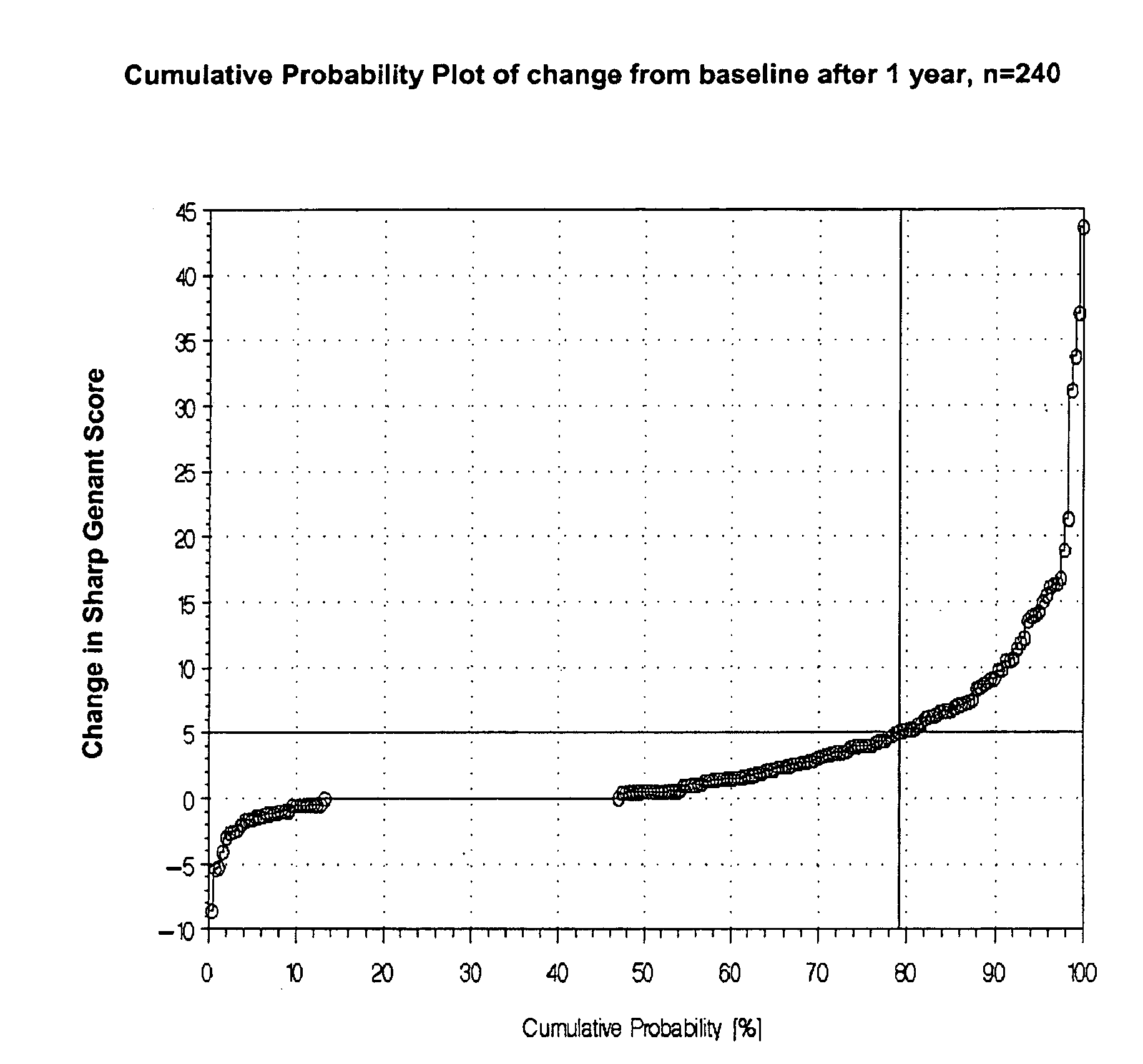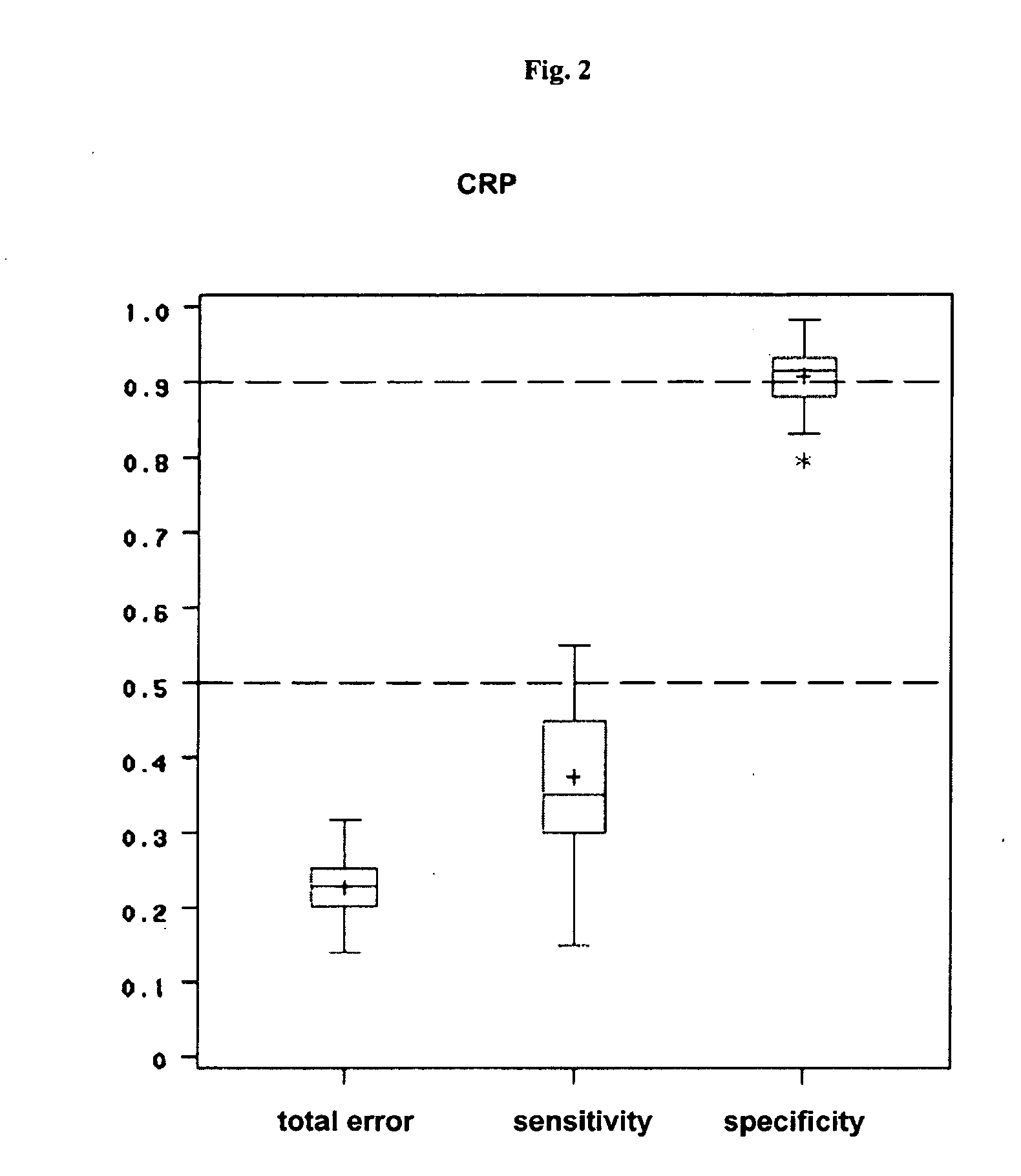Assessing risk of disease progression in rheumatoid arthritis patients
a rheumatoid arthritis and risk assessment technology, applied in the field of assessing the risk of disease progression in rheumatoid arthritis patients, can solve the problems of loss of function of the involved joints, intense pain and joint destruction, and structural damage progressing
- Summary
- Abstract
- Description
- Claims
- Application Information
AI Technical Summary
Benefits of technology
Problems solved by technology
Method used
Image
Examples
example 1
Study Population
[0114]Samples derived from 237 highly characterized RA patients with maximum disease duration of 15 years were collected in five European centers with a follow-up of one or two years. All individuals were diagnosed as RA-patients according to the 1987 revised criteria for the classification of Rheumatoid Arthritis from the American Rheumatism Association (Arnett, F. C., et al., Arthritis Rheum. 31 (1988) 315-324). All patients were documented with an extensive case report form (=CRF). The CRF included the Health Assessment Questionnaire, the SF36 Questionnaire, swollen and tender joint count, laboratory parameters, clinical history of relevant surgery, medication, co-morbidities and medication for co-morbidities. X-rays were taken from hands and feet at baseline, after one and after 2 years following a standardized procedure. Only the baseline samples obtained from the RA-patients were used in the measurement of the different analytes and the corresponding results we...
example 2
Determination of the Sharp-Genant-Scores
[0116]From each patient x-rays were taken from hands and feet at baseline and after one and two years. The conventional film radiographs were sent to Synarc (Synarc GmbH, Hamburg, Germany), where the hard copy films were digitized using a Lumiscan 200 high resolution digitizer. After quality check each image was read by an experienced radiologist and scored according the Genant-modified Sharp scoring.
Morphological Scoring of Radiographs
[0117]Bone erosions and joint space narrowing in the hands and feet were scored according to a Genant-modified Sharp grading scheme as described below. This grading scheme is based on the Genant-modified Sharp scoring technique.
[0118]Erosion Score Fourteen sites in each wrist and hand (four proximal interphalangeal and five metacarpophalangeal joints, the carpometacarpal joint of the thumb, the scaphoid bone, the distal radius and the distal ulna) and six joints in each foot (five metatarsophalangeal joints and ...
example 3
Classification of Patients in RA with Disease Progression and RA with No Disease Progression
[0125]There are some possibilities discussed in the literature for classification of disease progression. Beside the ACR and EULAR criteria, which are mostly used in pharmaceutical studies for assessing treatment response also the IIAQ score and the radiological scores can be used for classification of disease progression. The most preferred methodology is the use of the change of any radiological score after one year. We decided to use the total Sharp-Genant-Score and to determine the individual change of this score one or two years after the baseline value (=progression rate).
Progression rate (1)=change of Sharp-Genant-Score (SGS) from baseline to year 1.
Progression rate (2)=change of Sharp-Genant-Score (SGS) from baseline to year 2.
[0126]The next important step was to define a cut-off value for the progression rates to be able to classify the patients in RA with progression and RA without ...
PUM
| Property | Measurement | Unit |
|---|---|---|
| concentration | aaaaa | aaaaa |
| concentration | aaaaa | aaaaa |
| concentration | aaaaa | aaaaa |
Abstract
Description
Claims
Application Information
 Login to View More
Login to View More - R&D
- Intellectual Property
- Life Sciences
- Materials
- Tech Scout
- Unparalleled Data Quality
- Higher Quality Content
- 60% Fewer Hallucinations
Browse by: Latest US Patents, China's latest patents, Technical Efficacy Thesaurus, Application Domain, Technology Topic, Popular Technical Reports.
© 2025 PatSnap. All rights reserved.Legal|Privacy policy|Modern Slavery Act Transparency Statement|Sitemap|About US| Contact US: help@patsnap.com



